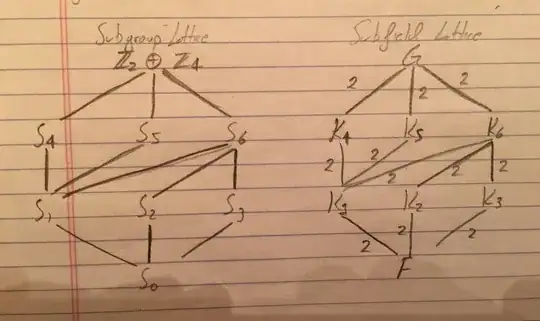The book I am using for my Abstract Algebra course is Contemporary Abstract Algebra by Joseph A. Gallian.
Let $E/F$ be a Galois extension with Galois group isomorphic to $\mathbb{Z}_2\oplus\mathbb{Z}_4$. Determine the subfield lattice for $E/F$.
I was wondering if someone could guide me into the right direction on how to solve this problem.
From what I do understand, Gal$(E/F)\cong \mathbb{Z}_2\oplus\mathbb{Z}_4$. Galois Theory, in a nutshell, is used to find how many subfields are between $E$ and $F$. If $E/F$ is "nice" then there is a one-to-one correspondence between the set of subfields and the set of subgroups.
I was able to find subgroups of the direct product $\mathbb{Z}_2\oplus\mathbb{Z}_4$. I don't know if I have found all subgroups to be honest with you. I did them by hand and wasn't sure if there was a theorem to verify if I got the right number of subgroups. The list is as follows.
- $S_0=\{(0,0)\}$, the trivial subgroup.
- $S_1=\{(0,0),(0,2)\}$
- $S_2=\{(0,0),(1,2)\}$
- $S_3=\{(0,0),(1,0)\}$
- $S_4=\{(0,0),(0,1),(0,2),(0,3)\}$
- $S_5=\{(0,0),(1,1),(0,2),(1,3)\}$
- $S_6=\{(0,0),(0,2),(1,0),(1,2)\}$
- $\mathbb{Z}_2\oplus\mathbb{Z}_4=\{(0,0),(0,1),(0,2),(0,3),(1,0),(1,1),(1,2),(1,3)\}$
From the information I got, we can see that $\mathbb{Z}_2\oplus\mathbb{Z}_4$ has 3 subgroups of order 4 and 3 groups of order 2. Hence we have 6 subfields between $E$ and $F$. This result in the following lattice.

Am I on the right track? Would the approach be similar if the Galois group was isomorphic to $\mathbb{Z}_3\oplus\mathbb{Z}_4$? Would there be a faster way to find the subgroups of direct products?
Sorry for the rather long read. I sincerely thank you for taking the time to read this post. I greatly appreciate any assistance you may provide.